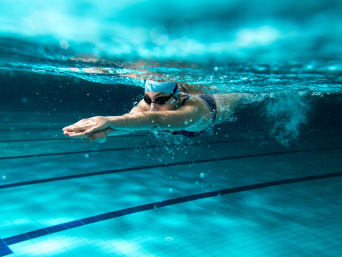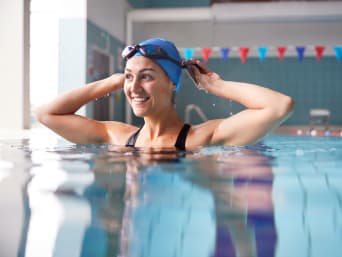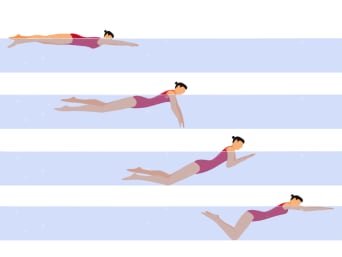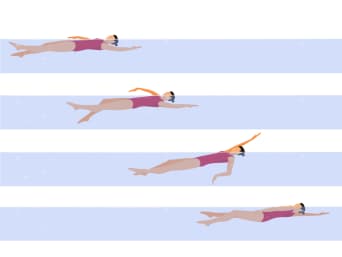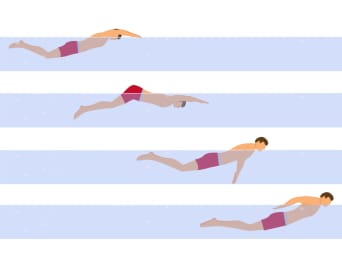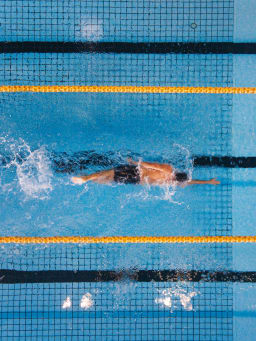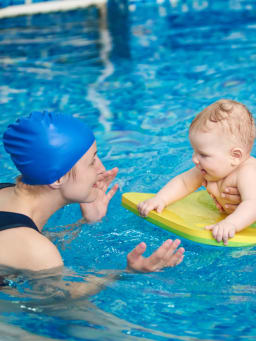Swimming - Health benefits of swimming and swimming techniques
Whether you use the lightness in the water to relax or go swimming regularly to train your endurance and muscle strength - hardly any sport is as versatile as swimming. The sport offers a holistic workout, whereby you can regulate the intensity of your session yourself at any time. Design your swimming training according to your taste: relaxed or challenging, alone or with friends, to relax or to increase performance. We give you an overview of the health benefits of swimming and introduce the most important swimming techniques.
Swimming as a sport – Healthy training for all age groups
If you want to train both your strength and endurance, but at the same time protect your joints, swimming is an ideal sport for you. When swimming, you complete a holistic workout. You can determine the intensity of the training yourself.
Health benefits of swimming
Solid swimming skills are not only vital; they also allow you to perform an effective full body workout. The health benefits are just as diverse as the sport itself.
Strengthening the cardiovascular system: swimming stimulates blood circulation and strengthens the cardiovascular system, which in turn has positive effects on the immune system. Moderate exercise gently strengthens the heart while increasing your lung capacity.
Strengthening the muscles: while swimming, the body has to fight against the resistance of the water, which builds muscles. Swimming engages nearly all your muscle groups.
Increase endurance and improve lung function: like other endurance sports, the respiratory muscles are trained during swimming. The breathing volume increases, which in turn has a positive impact on your endurance performance.
Relief of the spine, joints, and ligaments: under water, gravity does not act as strongly as on land, which makes a swimmer "lighter". Thus, the joints, tendons and ligaments are relieved during training in the water. The trunk muscles are strengthened and tension in the neck, shoulder and back is released.
Stress reduction: the steady movements and the almost floating feeling in the water that are perceived by many people as relaxing. When you swim, you can leave all the stress of everyday life behind and concentrate only on your training. Endorphins are also released during exercise, which create a noticeable feeling of happiness among many people.
Other reasons for swimming
Would you like to get started with swimming workouts as soon as possible? That is no problem. The equipment you need for swimming is very manageable and already available in most households: only a swimsuit, bikini or swimming trunks, slippers and well-fitting swimming goggles are necessary to start. Furthermore, for hygiene reasons and to protect your hair, you should possibly invest on a swimming cap.Another major advantage of swimming is that it is suitable for every age group, fitness level and training goal. Swimming can also be ideally combined with other sports if you are looking for more variety:
Complement to other sports; for example, to increase endurance
Balancing other sports: for example, for the regeneration phase in higher load/intensity sports
Prerequisite for water sports such as diving or surfing
Swimming as a sport for children and adults
Swimming is suitable for all age groups – and it's never too late to learn how to swim and practice it as a sport. Weightless swimming in the water is a lot of fun for children: during water familiarisation, babies and toddlers can therefore already gain initial experience with the element of water. Numerous positive effects on development can also be observed in older children.
Promoting motor skills while learning swimming techniques
Improving coordination through different movement sequences
Support healthy posture by strengthening the muscles
Increase self-confidence and social skills when joining a swimming club
At the same time, this joint-gentle sport is also ideal for elderly people. Gentle training increases strength and endurance without putting too much strain on the back, joints or tendons. Blood circulation improves, the metabolism is stimulated - this is a huge advantage for the immune system. Senior citizens also benefit from a sense of community in a swimming club.
The right swimming course
If you want your child to learn how to swim safely, or if you wish to improve your swimming skills, it is advisable to attend a swimming course first. You should pay attention to the following general conditions:
Professional, qualified course instructors ( check certificates if necessary)
Sufficient training sessions (between 10 and 20 hours)
Duration of the swimming sets (mostly 20 to 45 minutes)
Course frequency (at least between 1-2 times per week)
Small groups (about 6 to 8 participants for children)
Teaching swimming rules and compliance with their guidelines
For children: possibility to take a swim test
After the basic swimming lesson has been completed, many swimming clubs offer beginners' courses as well as advanced courses. The promotion of young talents in swimming clubs often helps and allows children and young people to move from leisure and popular sports to competitive sports.
Swimming for beginners
Don't push yourself too hard too quickly when swimming: even if you feel light in the water and the movements are smooth, swimming can still be exhausting for your muscles, cardiovascular system, and lungs.
Therefore, divide your swimming training into shorter sections at first. Concentrate on learning the right technique and increase your endurance. For example, train three times a week for 20 minutes or twice a week for 30 minutes and increase the intensity of your workout over time.
Especially for beginners, it is often difficult to evaluate your own fitness level or performance on your own. You can find professional guidance in many swimming clubs where you will also be taught how to train effectively.
Swimming techniques at a glance
Improving your swimming skills not only ensures that you get the most effective health benefits from the sport. Training in the right swimming techniques also makes children and adults feel safer in the water. This is especially true when swimming in open waters. There, the degree of difficulty is generally increased.
If you are interested in a more serious swimming training or improving certain techniques, a swimming coach or a swimming class can help. There are many options at a swimming school or a swimming club, often ranging from training for beginners and hobby sports to swimming training at competition level.
There you can learn how to perform the right movements properly and safely. In doing so, you will also prevent possible strain due to incorrect movement sequences or bad posture in the water. You can also find out which swimming technique suits you best for your training goals.
Swimming technique 1: the breaststroke
In many countries, breaststroke is learned as one of the first techniques. However, it is not necessarily a swimming technique for beginners: the swimming style is quite slow on the one hand, but also technically demanding.
Breaststroke movement sequences:
Arms are extended forward, and legs are extended in a straight line behind the body
Palms facing outwards, hands pushed to the side underwater, arms remain extended
Arms are pulled towards the body, then the legs start moving
When performing the leg kick, the legs are pulled with the heel in the direction of the buttocks
Feet rotate outwards, knees turn outwards
Legs move into a straddling position, soles of feet pointing towards the water surface.
Propulsion through circular swinging motion of the lower limb
Bring legs together in a half-circular motion
When swimming the breaststroke, make sure you only take a breath during the arm stroke and exhale underwater during the glide phase. Otherwise, you should keep your head underwater. If you permanently lift your face out of the water during the swim, you put too much strain on your neck and back.
Benefits of the breaststroke
All muscle groups are stimulated, balanced training of arm, shoulder, chest, leg, and gluteal muscles possible
Allows good orientation, as the viewing direction is in the direction of swimming
Disadvantages of the breaststroke
Incorrect posture can lead to tension in the neck and throat
Challenging movement sequence for coordination, often more difficult to learn
Swimming technique 2: the crawl
The crawl is the fastest swimming technique and is therefore often referred to as the "supreme discipline". The swimming style is very effective and also efficient if the technique is executed properly. In general, the movements are easier to learn, which is why the crawl is increasingly recommended as the first swimming technique for children.
Crawl movement sequences:
Arm is extended forward with elbow raised high, fingers are closed
Hand and arm are immersed in the water as far in front of the head as possible, fingertips first.
Bring the arm back towards the thigh, palms facing backwards
The arm is brought forward over the shoulder and immersed again.
Arm pull is done alternately
Meanwhile, the kicks of the almost outstretched legs contribute to the propulsion
Legs are alternately moved up and down (similar to a paddle movement)
In crawl, the body lies parallel to the water surface. The face points down into the water. To catch your breath, turn your head sideways out of the water every two to five arm movements.
Benefits of the crawl
Joint mobility is increased by stretching the shoulder and back area
The rotation of the arms trains the lateral trunk and arm muscles, the leg strokes strengthen the thigh muscles
Disadvantages of the crawl
Longer execution/performance requires strength endurance
Breathing coordination with arm movements must first be learned
Swimming technique 3: the backstroke
Due to the arm movements, this swimming technique is sometimes also called back crawl. It should be distinguished from the slow paddling in the back position, which is solely for relaxation.
Backstroke movement sequences:
Straight body position in the water, shoulders slightly higher than the pelvis
Arm pull is done alternately, palms pointing outwards
Stretched arm dives into the water over the head, little finger first
Under the water, the arm is bent slightly towards the body in the direction of the legs
Above the water, the movement starts over again with the other arm
Simultaneous and alternating leg kick, movement is from the hips
Back remains straight throughout, forceful leg stroke stabilises the body in the water
Breathing is quite easy in backstroke, as the face remains above the water. Therefore, swimming goggles are not essential. However, water may splash into your face during the swim.
Benefits of the backstroke
Strengthen the core muscles
Straight, stretched posture ensures gentle stretching of the joints
Supine position relieves the spine
Disadvantages of the backstroke
Orientation in the water is more difficult, as swimmers are unable to see where they are going
Swimming technique 4: the butterfly or dolphin stroke
In the 1930s, butterfly swimming was developed from breaststroke. It is also often referred to as dolphin swimming because of the closed leg stroke. Butterfly swimming is technically difficult and is one of the most strenuous swimming styles.
Butterfly or dolphin stroke movement sequences:
Both arms are extended forward shoulder-width apart, fingers are closed
Arms enter the water with thumbs first in front of the head, simultaneous stroke downwards of the legs
Hands and elbows are slightly bent and pulled backwards through the water, then the arms are brought forward again
Upper body completely submerged in water at each pull
While the arms are submerged, a strong leg kick is performed
Dolphin leg kick is achieved from the lower back, undulation extends from the legs down to the feet
A kick of both feet completes the wave-like movement
During the upward movement of the upper body your head is above water. At this moment you can take a breath - either at each or every second arm stroke.
Benefits of butterfly swimming
Provides a new, exciting challenge for experienced swimmers
Second fastest swimming technique, both strength and endurance are trained equally
Arm and back muscles are trained through the rotating arm movement
Strong leg kick builds leg muscles
Disadvantages of butterfly swimming
Not necessarily suitable for beginners due to its technical difficulty
Incorrect technique can lead to tension in the lower back or pain in the lumbar spine
Requires a lot of strength and coordination, therefore only suitable for shorter distances
Summary
There are many reasons to go swimming regularly: swimming supports the immune system, is an effective full-body workout and gives us a feeling of lightness. Swimming is therefore ideal for increasing general fitness or as a supplement to other sports. This versatile sport is suitable for all age groups and training levels, which is why it is never "too late" to start swimming. Exercising in water is fun even for small children - but to get the most out of your swimming training, you should learn the right technique in a swimming course. Then nothing will stop you from jumping into cold water!
______________________________________________
References:
https://www.yourswimlog.com/the-benefits-of-long-unbroken-swimming
(accessed on 07.02.2022)
https://allamericanswim.com/different-swimming-strokes
(accessed on 07.02.2022)
https://myswimpro.com/blog/2020/03/11/10-reasons-you-should-swim-every-day/
(accessed on 07.02.2022)
https://swimjim.com/blog/what-do-the-experts-say-about-how-to-be-happy-and-what-does-swimming-have-to-do-with-it-2/
(accessed on 07.02.2022)
https://www.safekids.org/tip/swimming-safety-tips
(accessed on 07.02.2022)
Images sources:
iStock.com/SolisImages
iStock.com/monkeybusinessimages
